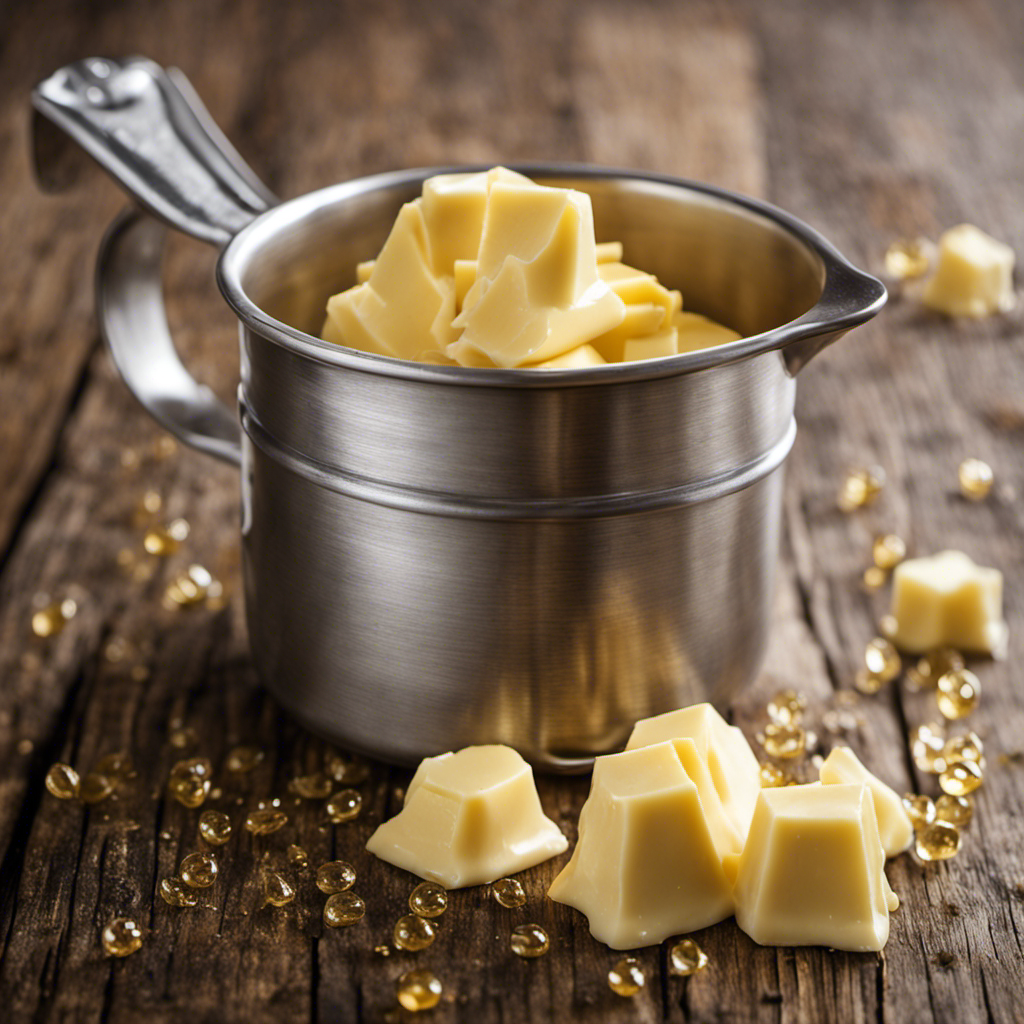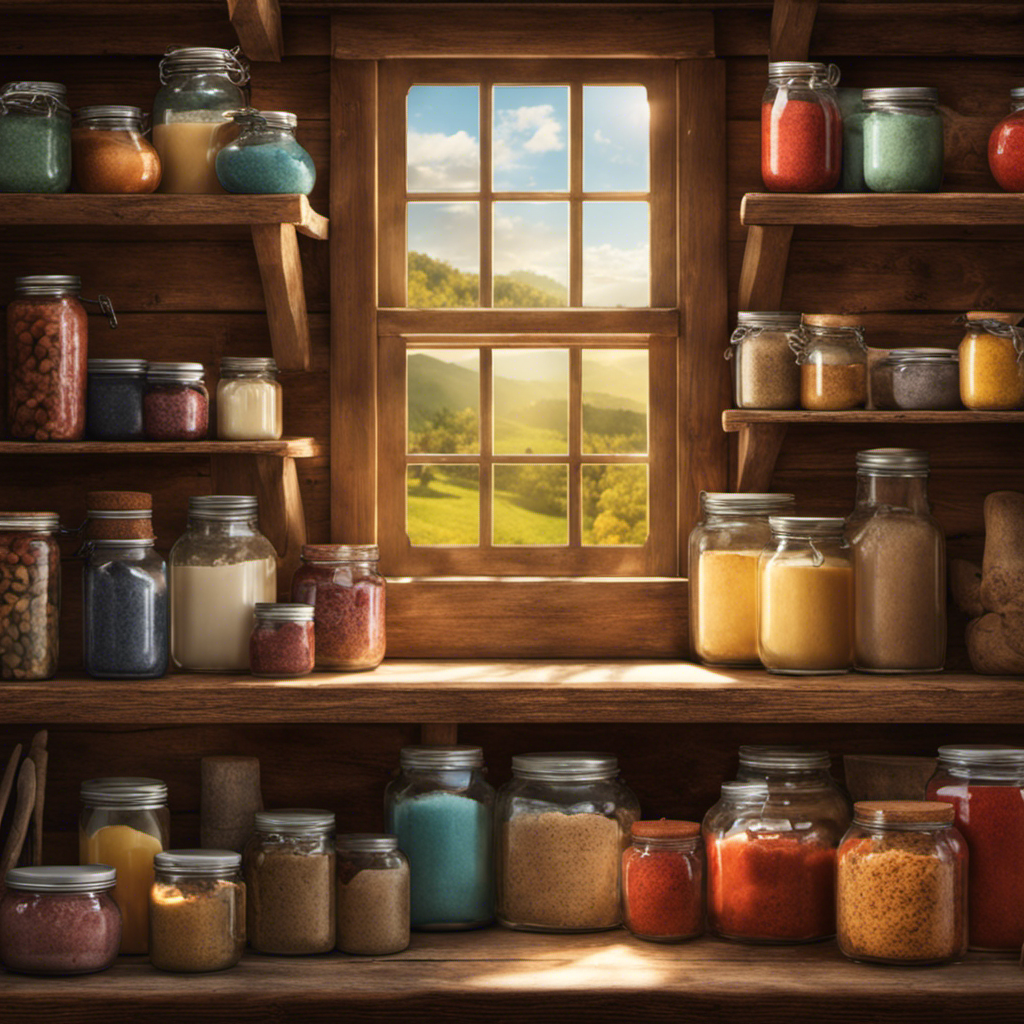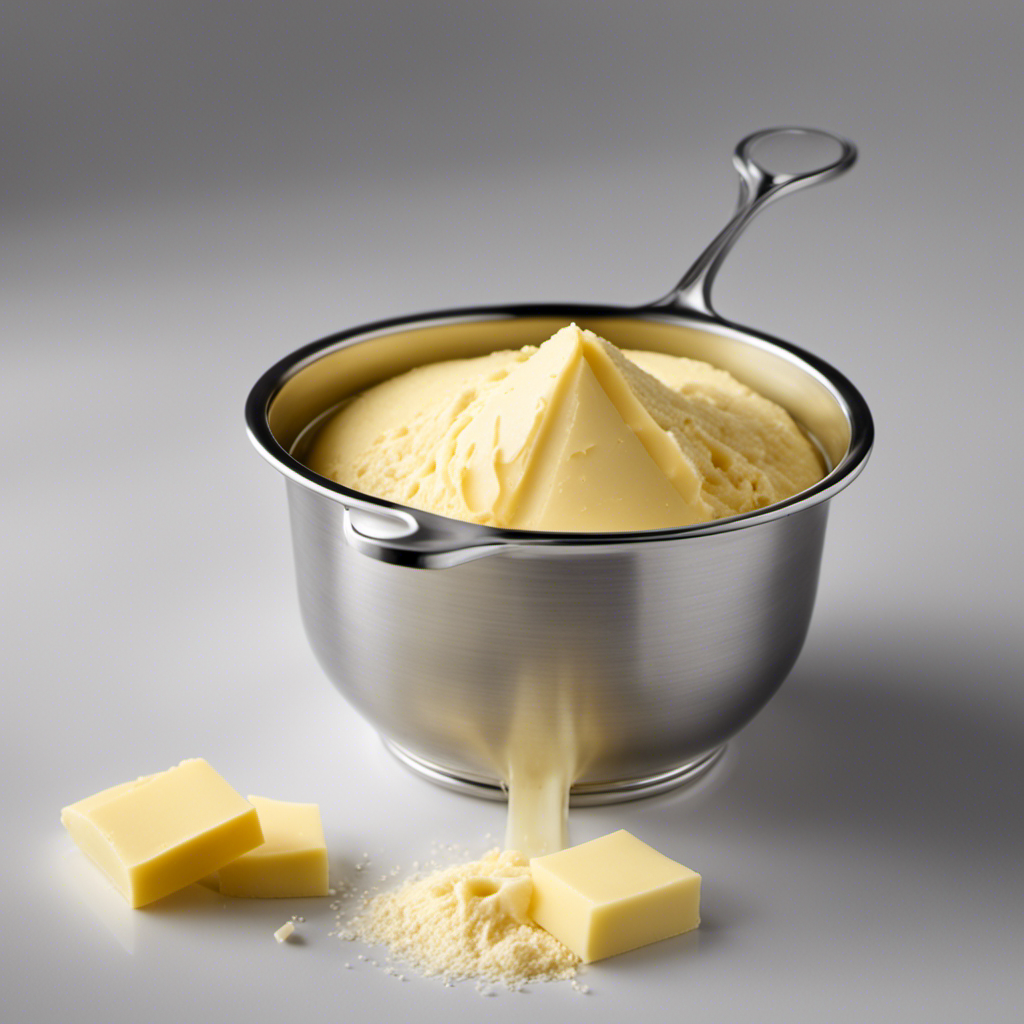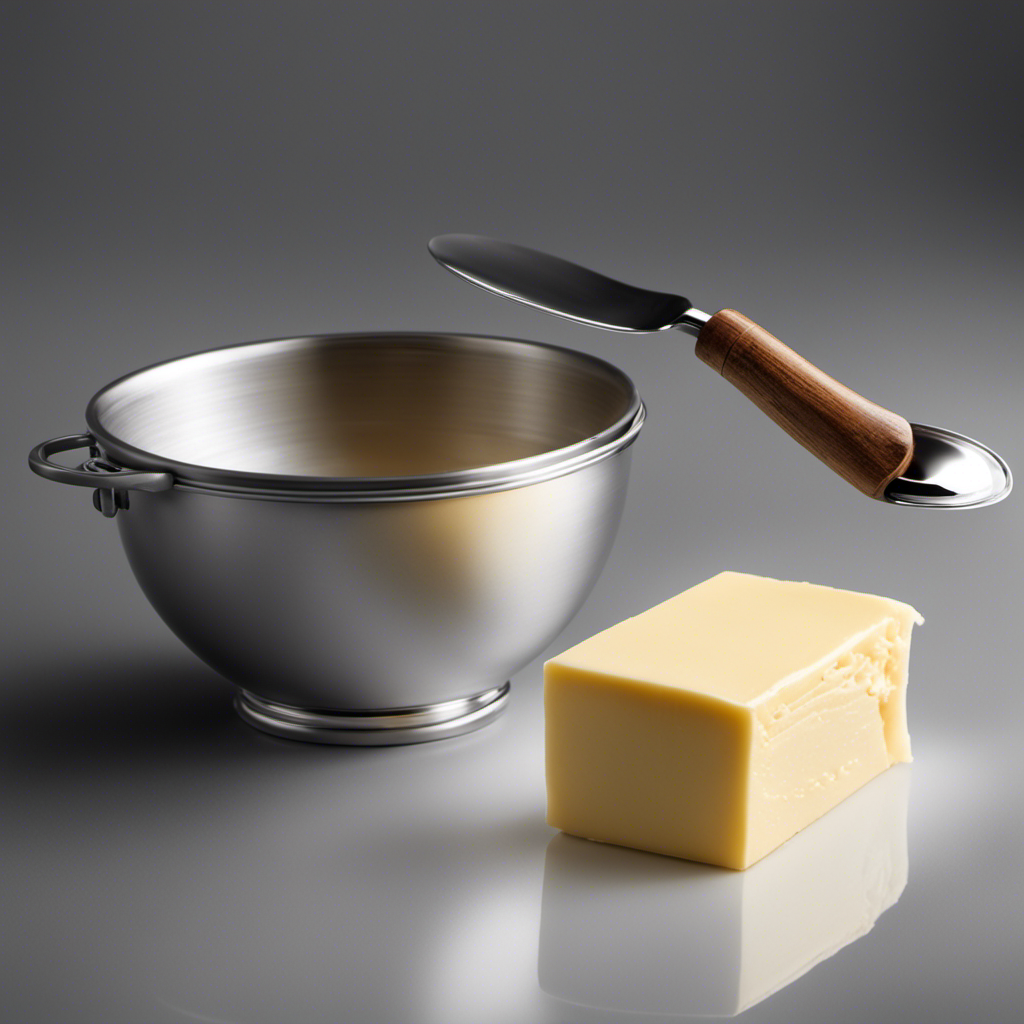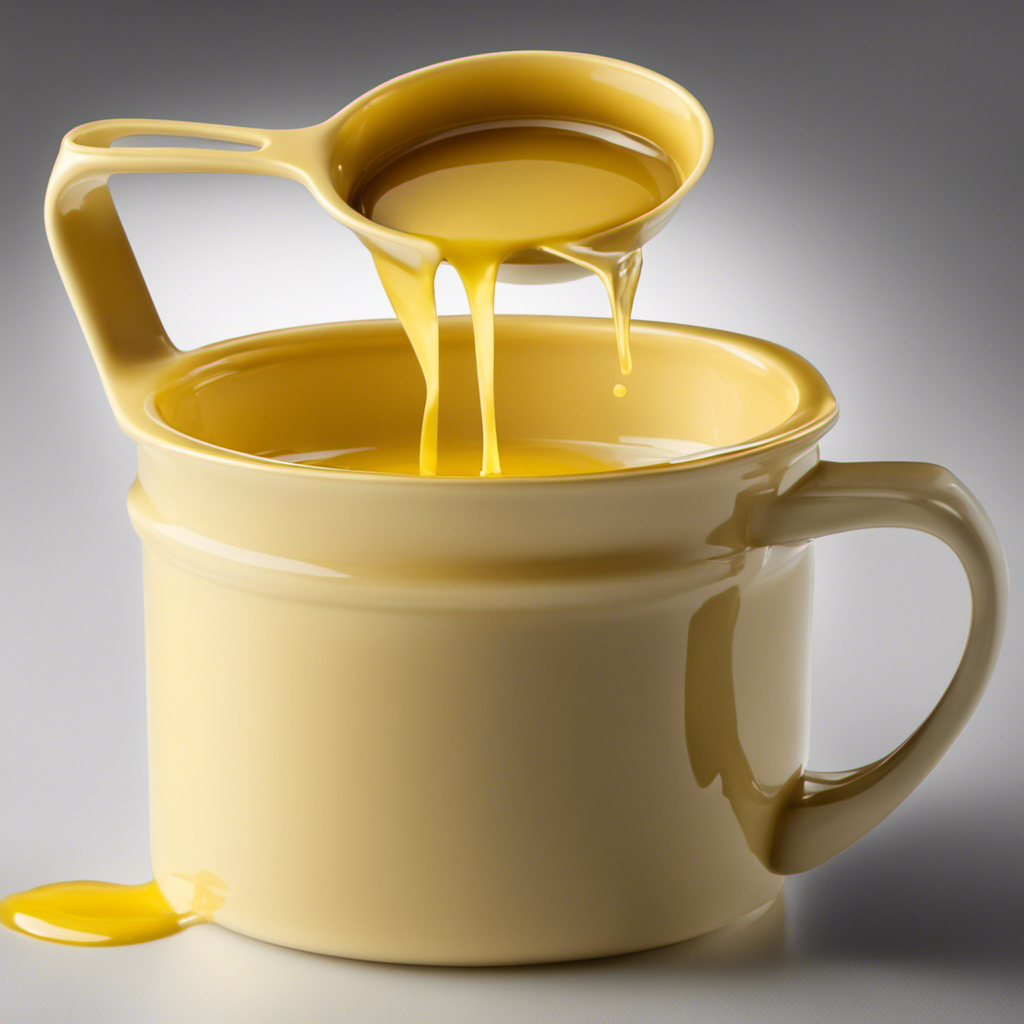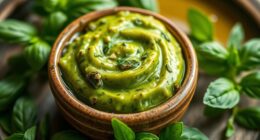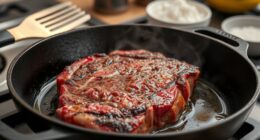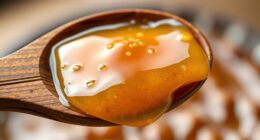I’m facing a creamy conundrum that requires resolution: exactly how many cups amount to 1lb of butter?
Join me on this journey as we dive into the world of butter measurements. From understanding the basic conversion of pounds to cups, to unraveling the science behind butter measurements, we’ll leave no stone unturned.
Whether you’re converting butter from weight to volume or adjusting measurements for different recipes, I’ve got the tips you need to ensure accurate butter measurement.
Let’s get ready to butter up!
Key Takeaways
- 1 lb of butter is equal to about 2 cups
- Conversion from weight to volume is necessary for accurate measurements
- Accurate measurement is crucial for precise recipe results
- Understanding the science behind butter measurements ensures consistent results
Basic Conversion: Pound to Cup
1 lb of butter is equal to about 2 cups. Understanding conversion ratios is essential when it comes to baking.
Many recipes call for specific measurements, and it’s crucial to know how to convert them accurately. In baking, common measurements are often given in cups, tablespoons, or pounds. For example, if a recipe requires 1 lb of butter, you can easily convert it to cups by dividing the weight by the conversion ratio. In this case, 1 lb of butter is equivalent to approximately 2 cups.
This conversion ratio helps ensure that your baked goods turn out just right. By familiarizing yourself with common baking measurements and understanding conversion ratios, you’ll be able to confidently follow any recipe and achieve delicious results.
Understanding Butter Measurements
To understand how much butter you need, it’s important to know the conversion between pounds and cups. Here are some helpful tips for measuring butter for cooking and converting butter for spreads:
- 1 pound of butter is equal to 2 cups.
- If a recipe calls for 1/2 cup of butter, you will need 1/4 pound or 1 stick of butter.
- For spreads, 1/4 cup of butter is equivalent to 4 tablespoons or 1/2 stick of butter.
- If you need to convert a specific amount of butter from cups to pounds or vice versa, you can use online conversion tools or refer to a butter conversion chart.
Converting Butter From Weight to Volume
When it comes to baking, accurate measurements are crucial for achieving the desired results. One common ingredient that often requires conversion is butter. Understanding how to convert butter from weight to volume and measuring it accurately can make a significant difference in your recipes.
In this discussion, I will delve into the topic of butter weight conversion and provide tips for measuring butter accurately, helping you achieve consistent and delicious results in your baking endeavors.
Butter Weight Conversion
There’s a simple way to convert pounds of butter to cups. If you’re looking to convert butter from grams to cups, here’s how you can do it:
- Understand the conversion ratio: 1 cup of butter is equal to 226.8 grams.
- Determine the weight of the butter in grams.
- Divide the weight of the butter in grams by 226.8 to get the equivalent number of cups.
- Round the result to the nearest decimal place for a more accurate measurement.
Converting butter from weight to volume can be helpful when following recipes that list the ingredients in cups rather than pounds or grams. By knowing the conversion ratio and following these steps, you can easily measure butter accurately in cups.
Now, let’s move on to the next section about measuring butter accurately.
Measuring Butter Accurately
Measuring butter accurately is crucial for precise recipe results. As a home cook, I understand the importance of getting the measurements right to ensure the perfect texture and flavor in my dishes. When it comes to measuring butter for cooking, there are a few methods you can use to ensure accuracy. One way is to use a kitchen scale to weigh the butter in grams or ounces. Another method is to use measuring spoons to measure out tablespoons or teaspoons of butter. However, if a recipe calls for cups of butter, it’s important to know the conversion. Here is a handy table to help you convert butter in recipes:
| Cups of Butter | Grams | Ounces |
|---|---|---|
| 1 | 227 | 8 |
| 1/2 | 113 | 4 |
| 1/4 | 57 | 2 |
| 1/8 | 28 | 1 |
Using this table, you can easily measure the right amount of butter for your favorite recipes. Happy cooking!
The Science Behind Butter Measurements
Understanding the science behind butter measurements can help home bakers achieve accurate results in their recipes. Here’s what you need to know:
-
Butter density: Butter is not uniformly dense throughout, which can lead to inconsistencies when measuring by volume. This is why weighing butter can provide more precise results.
-
Measuring butter by weight: By using a kitchen scale, you can measure butter in grams or ounces. This ensures that you have the exact amount needed for your recipe, eliminating guesswork.
-
Accuracy in baking: Baking is a science, and accurate measurements are crucial for successful outcomes. Using weight measurements for butter can help you achieve the desired texture, moisture, and flavor in your baked goods.
-
Conversion to cups: Once you know the weight of your butter, you can easily convert it to cups using a conversion chart or calculator. This allows you to follow recipes that specify butter in cup measurements.
Understanding the science behind butter measurements not only improves accuracy but also ensures consistent and delicious results in your baking endeavors. Now, let’s delve into the next section about converting 1 pound of butter to cups.
Converting 1 Pound of Butter to Cups
Now that we understand the science behind butter measurements, let’s talk about converting 1 pound of butter to cups.
When it comes to butter, there are 2 cups in 1 pound. This means that if you have a recipe that calls for 1 pound of butter, you will need 2 cups.
It’s important to note that butter is typically sold in sticks, and each stick is equal to 1/2 cup or 8 tablespoons. So, if you need to convert butter to tablespoons, simply multiply the number of cups by 16.
Aside from using butter in baking recipes, there are also alternative uses for this versatile ingredient. Butter can be used to make sauces, add richness to mashed potatoes, or even give flavor to grilled vegetables. Its creamy texture and rich taste make it a favorite ingredient in many dishes.
Now that we know how to convert butter to cups and tablespoons, let’s explore how butter measurements are used in baking recipes.
Butter Measurements in Baking Recipes
When it comes to baking, accurate measurements are crucial for achieving the desired results. One common measurement concern is converting butter from pounds to cups.
In this discussion, I will delve into the process of butter cup conversion, the importance of accuracy in measurements, and how to effectively substitute butter in recipes.
Butter Cup Conversion
To convert pounds of butter to cups, you simply divide the pound measurement by two and use the resulting number as your cup measurement. It’s as simple as that!
Here are a few things to keep in mind when converting butter from pounds to cups:
- Start with the pound measurement of butter you have.
- Divide that measurement by two to get the cup measurement.
- Use the resulting number as your cup measurement in your recipe.
- Keep in mind that butter equivalents can vary depending on the recipe and the country you are in. It’s always a good idea to double-check the specific conversion for your recipe.
When converting butter to grams, the process is a bit different. One pound of butter is equal to approximately 454 grams. So, if you’re looking to convert pounds of butter to grams, simply multiply the pound measurement by 454 to get the gram measurement.
Accuracy of Measurements
Make sure you double-check the accuracy of your measurements to ensure your recipe turns out just right. Understanding different butter forms and the impact of temperature on butter measurements is essential for accurate results in baking and cooking.
Butter is commonly sold in stick form, with each stick typically measuring 1/2 cup or 8 tablespoons. However, different brands may have slightly different measurements, so it’s crucial to refer to the packaging or measure it yourself.
Softened butter, which is typically used in baking, is measured by packing it into a measuring cup or using a scale. Remember that the temperature of the butter can affect its volume, so it’s important to measure it at the desired temperature specified in the recipe.
Substituting Butter in Recipes
Substituting butter in recipes can alter the texture and flavor of the final dish. It’s important to keep this in mind if you’re looking for a different option or if you have dietary restrictions. Here are some tips to help you navigate the world of butter alternatives and measurement techniques:
-
Choose the right substitute: There are various alternatives to butter, such as margarine, coconut oil, avocado, and applesauce. Each has its own unique flavor and texture, so choose wisely based on your recipe and personal preferences.
-
Adjust the measurements: When substituting butter with alternatives, it’s crucial to consider the differences in moisture content and fat content. Use online conversion tools or refer to recipe books that provide specific measurements for each alternative.
-
Experiment and taste: Don’t be afraid to experiment with different butter alternatives and measurements to find the perfect balance for your dish. Taste-test along the way to ensure you achieve the desired flavor and texture.
-
Use proper measurement tools: To accurately measure butter alternatives, use measuring cups or spoons specifically designed for liquids or solids. This will help you achieve consistent results in your recipes.
Handy Conversion Chart: Butter in Cups
Did you know that a pound of butter is equivalent to about 2 cups?
Understanding butter density is important when converting butter to grams.
To convert butter from cups to grams, you need to know the density of butter. The density of butter is usually around 0.95 grams per milliliter.
Since there are approximately 237 milliliters in a cup, you can calculate that there are about 225 grams of butter in one cup.
Therefore, if you have a pound of butter, which is equivalent to 2 cups, you would have approximately 450 grams of butter.
This conversion is useful when following recipes that require measurements in grams or when you want to ensure accuracy in your baking or cooking.
Converting Butter From Ounces to Cups
When it comes to measuring butter, there is often confusion around the different units of measurement. People often wonder how many cups are in a pound of butter or how to convert ounces to cups accurately.
In this discussion, I will provide a clear explanation of butter measurement confusion and offer precise and reliable methods for converting butter from ounces to cups.
Butter Measurement Confusion
Are you unsure about how many cups are in a pound of butter? Well, you’re not alone! Many people find themselves confused when it comes to measuring butter. To help clear up the confusion, I want to share some butter measurement techniques and common butter measurement mistakes to avoid. Here’s what you need to know:
-
Use a kitchen scale: The most accurate way to measure butter is by weighing it on a kitchen scale. This ensures you get the exact amount needed for your recipe.
-
Convert from pounds to cups: If your recipe calls for cups of butter and you only have a pound, you can convert it. One pound of butter is equivalent to about 2 cups.
-
Avoid using volume measurements: Butter can be tricky to measure using cups because its density can vary. It’s best to rely on weight measurements for accuracy.
-
Don’t guess: When it comes to baking, precision is key. Guessing the amount of butter can lead to inconsistent results. Always measure carefully to ensure your recipe turns out as intended.
Precise Butter Conversion
To convert a pound of butter into cups, you can use a ratio of approximately 2 cups per pound. It’s important to understand butter density when converting from grams to cups. Butter is denser than water, so it takes up less space.
When converting, it’s best to use a conversion chart or calculator to ensure accuracy. To convert grams to cups, you need to know the density of the butter you’re working with. Different brands and types of butter may have slightly different densities, so it’s always a good idea to check the packaging for specific conversion information.
Measuring Butter in Different Forms
You can easily measure butter in different forms by knowing the conversion from pounds to cups. Here’s a helpful guide to measuring butter in recipes and converting butter from grams to cups:
-
Stick of Butter: In the United States, a standard stick of butter weighs 1/2 cup or 8 tablespoons (113 grams).
-
Pound of Butter: A pound of butter is equivalent to 2 cups or 32 tablespoons (454 grams).
-
Grams to Cups: To convert butter from grams to cups, divide the weight in grams by 227 (the weight of 1 cup of butter in grams).
-
Example: If you have 250 grams of butter, divide 250 by 227 to get approximately 1.1 cups.
Knowing these conversions will ensure that you can accurately measure butter for your recipes and achieve the desired results. Happy baking!
Adjusting Butter Measurements for Different Recipes
Now that we know how to measure butter in different forms, let’s talk about adjusting butter measurements for different recipes.
Baking can require different amounts of butter depending on the type of recipe. For example, if you’re making cookies, you might need to adjust the butter measurement to get the desired texture.
In general, if you want a softer and more tender baked good, you can increase the amount of butter. On the other hand, if you want a drier and crumblier texture, you can decrease the butter.
It’s important to note that adjusting butter measurements can affect the overall flavor and texture of your baked goods, so it’s a good idea to experiment and find the right balance.
If you’re looking for alternative options to butter in recipes, you can try using coconut oil, vegetable oil, or even applesauce as substitutes. These alternatives can help you achieve different flavors and textures in your baked goods.
Tips for Accurate Butter Measurement
When measuring butter, it’s important to use the correct measuring tools to ensure accuracy. Here are some tips to help you measure butter accurately:
-
Use a kitchen scale: Weighing the butter on a scale is the most accurate way to measure it. This is especially important for recipes that require precise measurements.
-
Use measuring cups: If you don’t have a scale, you can use measuring cups. Remember to pack the butter firmly into the cup and level off the top for an accurate measurement.
-
Follow the markings on the butter wrapper: Most butter wrappers have markings to help you measure tablespoons or teaspoons. This can be a convenient way to measure smaller amounts of butter.
-
Use a butter dish with measurements: Some butter dishes come with markings on the side, allowing you to easily measure the amount of butter you need.
Frequently Asked Questions
Can I Use a Different Type of Fat Instead of Butter in a Recipe?
Yes, you can substitute butter with different types of fats in a recipe. There are various alternatives like vegetable oil, coconut oil, or margarine. However, keep in mind that the texture and flavor may vary.
How Does the Temperature of the Butter Affect Its Measurement in Cups?
The temperature of butter can affect its measurement in cups. Butter has a melting point around 90°F, so if it’s too cold or too warm, it may not measure accurately. To quickly soften butter, you can use several methods like microwaving or grating.
How Do I Measure Butter if I Don’t Have a Scale?
When I don’t have a scale, I measure butter by using the conversion chart. It’s like finding my way without a map, but it works! Grams to cups, no problem!
Can I Substitute Margarine for Butter in a Recipe?
Yes, you can substitute margarine for butter in a recipe. However, there are pros and cons to consider. Margarine can alter the taste and texture, so it’s important to choose a high-quality brand for best results.
How Do I Convert Tablespoons of Butter to Cups?
Converting tablespoons of butter to cups can be tricky, but with a little math, it’s easy. Just remember that 1 cup equals 16 tablespoons. Don’t forget to adjust for different types of fats.
Conclusion
In conclusion, understanding butter measurements is essential for accurate and successful baking. Converting 1 pound of butter to cups can be a bit tricky, but with the knowledge and tips provided, you can easily navigate through different recipes.
Remember, precision is key when it comes to measuring butter, so use the appropriate tools and techniques.
So, next time you’re in the kitchen, don’t let butter measurements ‘slip through your fingers’ – measure carefully and enjoy delicious results!
